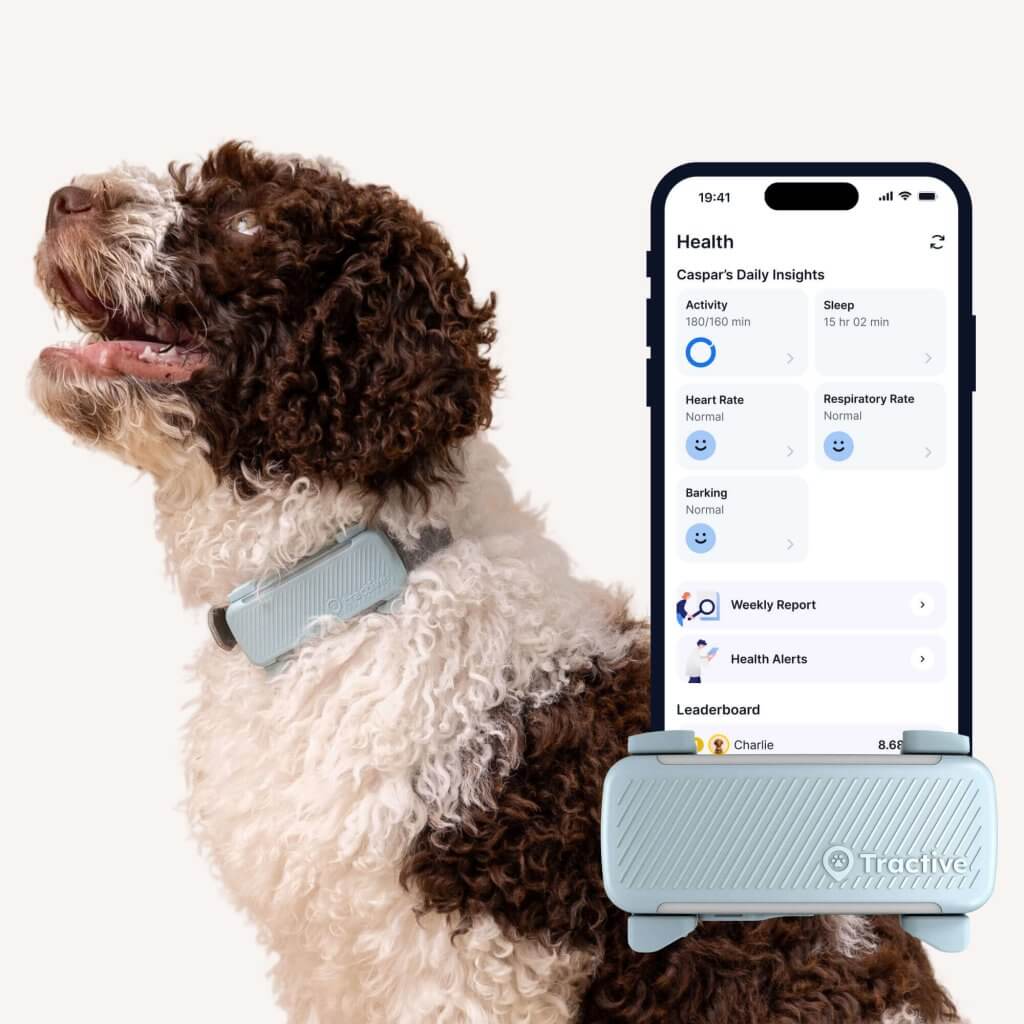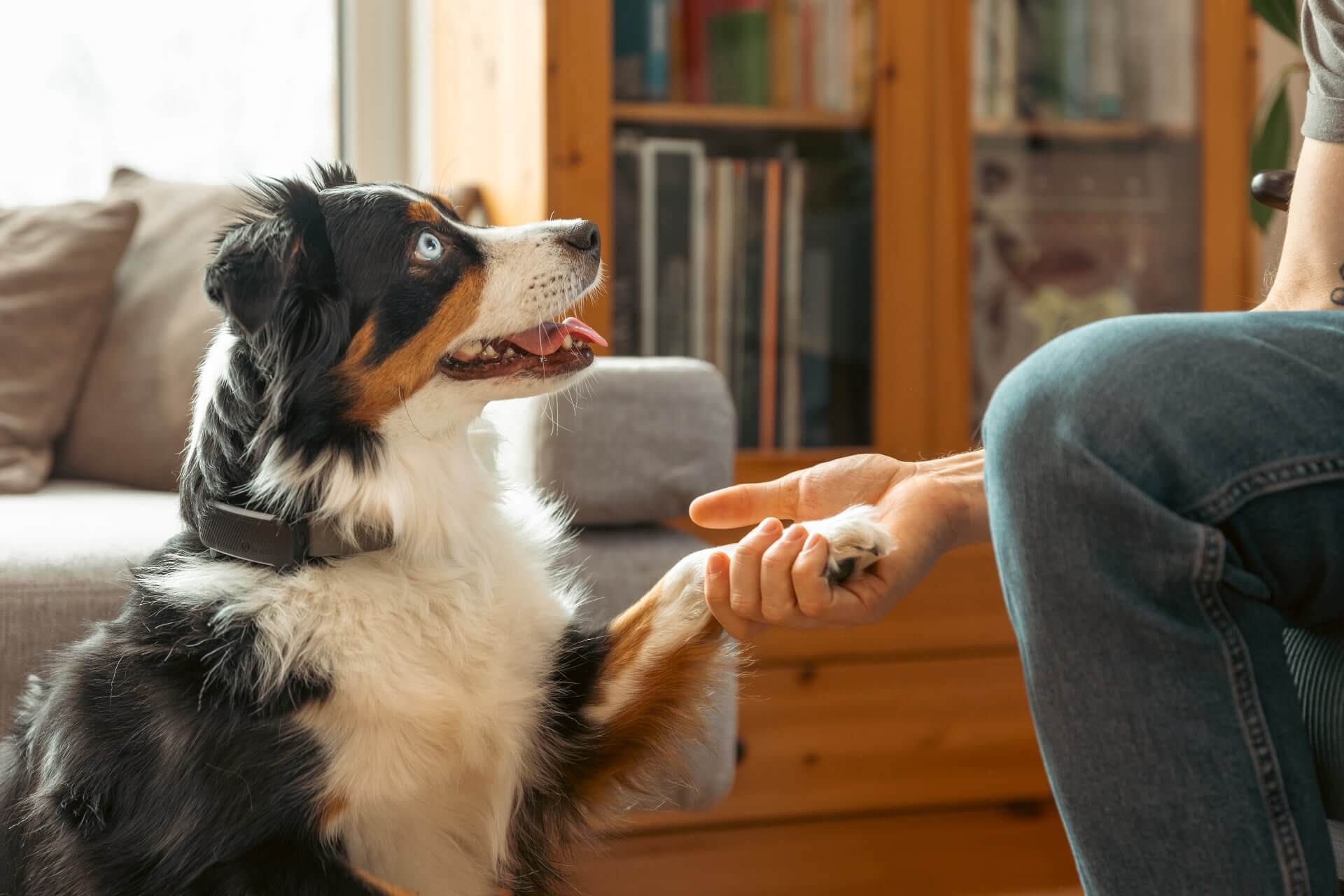 Approved by Dr. Dwight Alleyne, DVM
Approved by Dr. Dwight Alleyne, DVM Dealing With A Dog Panic Attack: How to Help Your Buddy
Your dog might not be able to tell you when they're stressed - so here's how to pick up on the signs of a dog panic attack before it worsens. (With a little help from a GPS & Health tracker, of course.)

If you’ve ever noticed your dog suddenly trembling, panting heavily, or acting out of character, you might be witnessing the signs of a panic attack. In this post, we’ll dive into what a dog panic attack looks like, the common symptoms, and most importantly, how you can help your dog during these overwhelming moments. Plus, we’ll explore how a GPS and Activity Tracker with built-in bark detection and separation anxiety monitoring can help you pre-empt a panic attack and take action early on.
Key Takeaways
Panic attacks are distinct from general anxiety
A panic attack is an acute, sudden episode of extreme distress that is more intense than general anxiety. It triggers a dog’s “fight-or-flight” response, leading to a surge of stress hormones.
Common symptoms and triggers
Symptoms include trembling, excessive panting, aggression, pacing, and destructive behavior. Triggers can include loud noises, separation anxiety, past trauma, overstimulation, and health issues.
How to help a dog during an attack
Stay calm, create a safe space, and use toys or walks to distract the dog.
The Tractive smart dog tracker can help in an emergency
Your Tractive device can help you by monitoring your dog for unusual barking, pacing, and changes in activity or sleep patterns. These features can provide early warnings of stress and allow you to intervene, even when you’re not around to help your dog directly.

Always know your buddy is healthy & safe
Read moreWhat is a dog panic attack?
Just like humans, dogs can experience panic attacks, which are intense and overwhelming reactions to fear or anxiety. A panic attack is an acute episode of distress, usually accompanied by physical and behavioral symptoms that can escalate quickly. Unlike general anxiety, which can be persistent and mild, a panic attack is often sudden and extreme, leaving a dog feeling terrified and disoriented.
During a panic attack, a dog’s fight-or-flight response is activated, leading to a surge in stress hormones such as cortisol and adrenaline. This can cause rapid, erratic behavior, making it difficult for the dog to focus or calm down. These episodes can last from a few minutes to half an hour and may subside once the trigger is removed or the dog is comforted.
Panic attacks in dogs can be triggered by a variety of environmental, social, or medical factors. Recognizing these attacks and their causes is key to preventing and managing them effectively.
The signs of a panic attack in dogs
Panic attacks can manifest in various ways, but common symptoms include:
- Trembling or shaking
- Unexpected aggression
- Excessive panting (often without physical exertion)
- Dilated pupils
- Pacing or restlessness
- Increased vocalization, including whining or barking
- Destructive behavior, including scratching at doors, chewing on furniture, or trying to escape
- Accidents around the house
- Clingy or avoidant behavior, with some dogs staying close to you – while others try to hide instead.
💡A smart dog tracker with built-in Bark Monitoring can help you pick up on a change in your dog’s normal bark levels – especially if it’s persistent or combined with other anxious behaviors, like pacing or even escape attempts. We’ll cover it in detail a little further below.

Get health alerts for your dog
Our pups can’t always tell us if something’s wrong. But if their tracker detects unusual changes in their routine, you’ll get an alert, helping you catch potential issues early.
What can trigger panic in dogs?
- Loud noises
Like thunderstorms, fireworks, or loud music. Many dogs have sensitive hearing, and sounds that might not seem as alarming to us can be overwhelming for them. Sudden bursts of loud noise, bright flashes, and even the pressure changes in the air can make a dog feel trapped and terrified. - Separation anxiety
When left alone for long periods or if you leave home, some dogs experience separation anxiety. This can lead to panic attacks as they feel isolated and unsure of what’s happening. Which might turn up as destructive behavior, excessive barking or whining, and attempts to escape. - Past trauma or abuse
If a dog has experienced physical punishment, neglect, or abandonment, it can cause long-term emotional damage, leaving them anxious or fearful in certain situations. - Health issues
Illnesses, injuries, or pain can make a dog feel vulnerable and anxious. Certain neurological or hormonal imbalances can also trigger heightened anxiety responses, including panic attacks. - Overstimulation
Sometimes, dogs can become overstimulated by too much activity or excitement, leading to anxiety and panic. Overstimulation can be particularly common in highly active or nervous dogs, especially if there are multiple people or pets around, loud sounds, or unpredictable events. - Genetics and breed predisposition
Breeds that are more sensitive, such as herding dogs or smaller toy breeds, can be more prone to stress and anxiety.
Is it a panic attack – or anxiety instead?
While anxiety and panic attacks share similarities, they’re still different conditions and need different approaches to manage it over time.
| Anxiety | Panic Attack |
|---|---|
| Develops gradually over time | Sudden and intense |
| Can persist for long periods | Short-lived but highly intense |
| Mild to moderate | Severe and overwhelming |
| Often related to specific stressors (e.g., separation, loud noises) | May occur without an identifiable trigger |
| Whining, pacing, mild restlessness | Shaking, rapid breathing, extreme distress |
| Dog may calm down with reassurance | May require more intervention to settle |
Read more: Managing Anxiety In Dogs: Your Ultimate Guide
How to stop a dog panic attack
- Stay calm and reassuring
If you stay calm, your dog is more likely to calm down as well. Take some slow, deep breaths yourself to help your dog mirror your actions. - Create a safe space
Move your dog to a quiet, familiar space – ideally a dimly-lit room with a cozy bed or crate. Soft music or a white noise machine, or even relaxing scents like lavender can help ease their nerves. - Give your dog some extra attention
Whether that’s cuddles, a gentle brush, or a massage. Weighted blankets or anxiety wraps (like a ThunderShirt) can apply soothing pressure similar to a hug. - Distract your dog
With a favorite toy, a chew treat, or a simple game to redirect their focus away from their panic. Else, take them out for a walk or revisit your basic training with commands like “Sit” or “Stay” to help them focus. - Don’t skip the workout
Whether physical (with regular walks and playtime) or mental (with regular training.) Most dogs need at least 30 minutes of exercise per day to stay healthy. This, combined with regular obedience training, can help them feel more secure and less prone to panic. - Get in touch with your vet
They can best recommend behavior modification techniques, medication, or natural supplements to help manage anxiety. - Never punish a dog for panicking.
They’re not misbehaving; they’re reacting out of fear. In times like these, try and figure out what triggered their panic attack instead. (Like loud noises or you leaving home.) So you can take steps to remove the stressor from the environment or plan ahead for what you’ll do if you can’t monitor your dog 24/7.
Where a GPS & Health Tracker can step in
Your dog might not be able to tell you they’re stressed or panicking. But with a little vigilance, patience, and an extra pair of eyes on them, you can catch on to the signs of a panic attack much before it has a chance to worsen. A GPS & Health tracker can be an extra pair of eyes on your dog – especially when you’re not around to comfort them.

With the Tractive GPS, you can pick up on the early signs of stress and prevent them from escalating into a full-blown panic attack. Yours comes equipped with:
- Bark monitoring
Which helps track unusual barking patterns, especially those indicating anxiety or distress. By monitoring changes in barking frequency and intensity, you can figure out if your dog seems to be more stressed than usual. - Separation anxiety monitoring
Switch on via your Tractive mobile app and check if your dog seems to be pacing restlessly or showing any behaviors that might signal anxiety. Increased movement or sudden bursts of activity can signal distress. So you can intervene early by getting a friend or neighbor to check up on your dog.

- Activity tracking
With its built-in motion detector, your Tractive device monitors your dog’s movements all day long. Helping you figure out earlier if there’s a sudden spike in energy or excessive stillness. All of which could indicate a panic episode. - Sleep tracking
Which monitors your dog’s sleep quality and helps identify disruptions in your dog’s sleep cycle. All of which could be a sign of underlying anxiety issues. - Real-time alerts
Which notify you of sudden changes in behavior, allowing you to take immediate action to comfort your dog.
Your furry friend’s health and wellbeing means as much as to us as it does to you. So we’ve made it a priority to only share medically-relevant content on our blog. This post was checked, double-checked, and medically verified by Georgia-based vet, Dr. Dwight Alleyne.

Dr. Dwight Alleyne, DVM
Originally from Long Island, New York, Dr. Alleyne began his career at a no-kill animal shelter before becoming a licensed veterinary technician. He graduated from Cornell University Veterinary College in 2006 and completed an internship at Purdue University. Now practicing in Georgia, Dr. Alleyne specializes in soft tissue surgery and ultrasounds. He also writes pet health articles on his website, “The Animal Doctor Blog” (www.anmldrblog.com).



